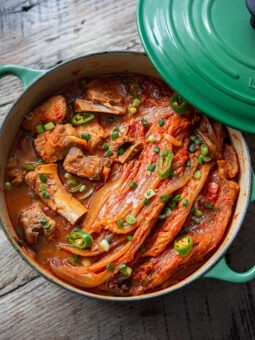Korean Soy Bean Paste (Doenjang)
Korean soybean paste (doenjang, 된장) is made of fermented soybeans. It’s a signature Korean condiment and unique to Korean cuisine. Doenjang is known for its healthy benefit with a rich source of good bacteria, Bacillus subtilis. Since it is made of fermented beans, it is quite strong in flavor; pungent, robust, nutty and full of umami. It has a chunky consistency.
How is donajng made
Doenjang is made of fermented soybean and sea salt brine. Korean soup soy sauce is the by-product of the doenjang fermentation. Soybeans are soaked overnight, boiled in salt water, and pounded in a mortar to coarsely ground. The paste is then shaped into a brick called Meju (메주), dried bricks of fermented soybeans. Meju bricks are hanged to dry, which collects a good batería during the drying period, then soaked in a salty brine within a charcoal-smoked earthenware crock for a fermentation period ranging from weeks to years.
Is doenjang gluten free?
Homemade doenjang that has followed traditional method should be gluten-free. The authentic doenjang is made with rice, soybeans, and salt only. However, many commercially made doenjang contains some wheat, which makes it difficult to be a gluten-free. If you are looking for a gluten-free doenjang, check the link below the post.
How to use doenjang
Korean soybean paste is usually used as the main seasoning ingredients for Korean soup and stews. “Ssamjang”(dipping sauce for lettuce wrap) is also can be used to season blanched vegetables such as spinach, cabbage or broccoli rabe.
Doenjang jjigae: This famous Korean soybean stew has doenjang as its base and includes tofu, onion, zucchini, mushroom as well as meat or seafood.
Ssamjang: Korean doenjang can also be eaten raw as a dipping sauce or mixed with gochujang (red chili paste) to make ssamjang to use as a topping sauce for Korean BBQ dishes or lettuce wraps. Learn how to make ssamjang at home.
Marinade: Doenjang is also often used in marinating pork to make unqiue Korean grilled pork dish called Mackjeok.
Seasoning: Various Korean vegetable side dishes (namul) are seasoned with donajang to add a pungent flavor. Vegetable recipes like spinach side dish, soybean cabbage or broccoli rabe with soybean paste are wonderful example of using doenjang as a flavoring agent.
Types of Doenjnag
- Jaeraesik doenjang(재래식) – slow fermentation for 6 months or more. It produces the Korean soup soy sauce as a by-product. It includes the remaining of soybean solids.
- Tojang (토장) – 1-2 months fermentation. The process of making this deonjang skips the traditional meju (soy paste bricks) which makes the soup soy sauce production. It also includes wheat in the process of fermentation creating sweeter in taste.
- Bori doenjang (보리된장) – Instead of rice, barley is used as a starch component.
- Joge doenjang (조개된장) – preseasoned paste for soups and stews. This all-in-one product that is designed to use in soups and stews. You don’t need to make a separate soup stocks since it has all the flavor included.
How to store doenjang
Once opened, keep your container in the fridge. Most commercial brands will keep for about a year. The color on the surface of doenjang paste might turn dark, but it is still usable and great for soups. If you doenjang is dried out and cracking, you should discard and get a new one.







